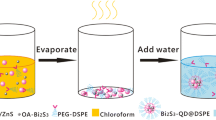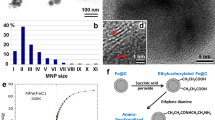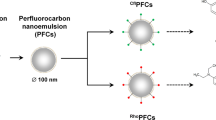Abstract
Bacterial magnetic particles (BMPs) are of interest as potential carriers of bioactive macromolecules, drugs, or liposomes. In this study, a high-pressure homogenizer was used to disrupt Magnetospirillum gryphiswaldense strain MSR-1 cells, and BMPs were purified. BMPs were labeled with fluorescence reagent 1,1′-dioctadecyl-3,3,3′,3′-tetramethylindocarbocianin perchlorate (DiI) and injected into the tail vein of BALB/c nude mice. Distribution of fluorescence signals of DiI–BMPs in vivo was examined using a whole-body fluorescence imaging system. The result showed that fluorescence signals were detected in liver, stomach, intestine, lungs, and spleen. However, transmission electron microscopy of ultrathin sections indicated that BMPs were mainly present in liver and lungs, but not in the other organs. BMPs could be useful as carriers for targeted drug therapy of diseases of the liver or lung.




Similar content being viewed by others
References
Balkwill DL, Maratea D, Blakemore RP (1980) Ultrastructure of a magnetic spirillum. J Bacteriol 141(3):1399–1408
Bazylinski DA, Frankel RB (2004) Magnetosome formation in prokaryotes. Nat Rev Microbiol 2:217–230
Bazylinski DA, Garratt-Reed AR, Frankel B (1994) Electron-microscopic studies of magnetosomes in magnetotactic bacteria. Microsc Res Tech 27:389–401
Blakemore RP (1975) Magnetotactic bacteria. Science 190:377–379
Bury D, Jelen P, Kalab M (2001) Disruption of Lactobacillus delbrueckii ssp. bulgaricus 11842 cells for lactose hydrolysis in dairy products: a comparison of sonication, high-pressure homogenization and bead milling. Innov Food Sci Emerg Technol 2:23–29
Dai W, Hale SL, Martin BJ, Kuang JQ, Dow JS, Wold LE, Kloner RA (2005) Allogeneic mesenchymal stem cell transplantation in postinfarcted rat myocardium short- and long-term effects. Circulation 112:214–223
Faivre D, Schüler D (2008) Magnetotactic bacteria and magnetosomes. Chem Rev 108(11):4875–4898
Geciova J, Bury D, Jelen P (2002) Methods for disruption of microbial cells for potential use in the dairy industry—a review. Int Dairy J 12:541–553
Gonzalez JB, Orth M, Schaefer M, Tauber R (2006) Endocytosis and intracellular trafficking of fatty acid esters of phenylaminopropanediol, the putative etiologic agents of the toxic oil syndrome (TOS). Toxicol Lett 163:206–212
Hartung A, Lisy MR, Herrmann KH, Hilger I, Schüler D, Lang Bellemann ME, Kaiser WA, Reichenbach JR (2007) Labeling of macrophages using bacterial magnetosomes and their characterization by magnetic resonance imaging. J Magn Magn Mater 311(1):454–459
Higuchi Y, Nakamura H, Kawasaki M, Takahashi S (2005) The dynamics of precursor cells in the olfactory epithelium of juvenile and adult guinea pigs. Eur Arch Otorhinolaryngol 262:64–68
Hoell A, Wiedenmann A, Heyen U, Schüler D (2004) Nanostructure and field-induced arrangement of magnetosomes studied by SANSPOL. Physica B 350:309–313
Hopkin M (2004) Magnet-making bacteria could target tumours. Nature. doi:10.1038/news040906-11
Jia LJ, Takahashi M, Morimoto H, Takahashi S, Izawa A, Ise H, Iwasaki T, Hattori H, Wu KJ, Ikeda U (2006) Changes in cardiac lipid metabolism during sepsis: the essential role of very low-density lipoprotein receptors. Cardiovasc Res 69:545–555
Juillerat-Jeanneret L, Schmitt F (2007) Chemical modification of therapeutic drugs or drug vector systems to achieve targeted therapy: looking for the grail. Med Res Rev 27(4):574–590
Kim JS, Yoon TJ, Yu KN, Kim BG, Park SJ, Kim HW, Lee KH, Park SB, Lee JK, Cho HM (2006) Toxicity and tissue distribution of magnetic nanoparticles in mice. Toxicol Sci 89(1):338–347
Kouki T, Yamanouchi K (2007) Postnatal development of septal projections to the midbrain central gray in female rats: tract-tracing analysis with DiI. Neurosci Lett 411:37–41
Lang C, Schüler D, Faivre D (2007) Synthesis of magnetite nanoparticles for bio- and nanotechnology: genetic engineering and biomimetics of bacterial magnetosomes. Macromol Biosci 7:144–151
Levine AJ, Munoz-Sanjuan I, Bell E, North AJ, Brivanloua AH (2003) Fluorescent labeling of endothelial cells allows in vivo, continuous characterization of the vascular development of Xenopus laevis. Dev Biol 254:50–67
Li H, Zhang ZH, Blessington D, Nelson DS, Zhou R, Lund-Katz S, Chance B, Glickson JD, Zheng G (2004) Carbocyanine labeled LDL for optical imaging of tumors. Acad Radiol 11:669–677
Li X, Jiang W, Sun JB, Wang GL, Guan F, Li Y (2007a) Purified and sterilized magnetosomes from Magnetospirillum gryphiswaldense MSR-1 were not toxic to mouse fibroblasts in vitro. Lett Appl Microbiol 45(1):75–81
Li X, Wang B, Jin HL, Jiang W, Tian JS, Guan F, Li Y (2007b) Bacterial magnetic particles (BMPs)-PEI as a novel and efficient non-viral gene delivery system. J Gene Med 9:679–690
Li JH, Pan YX, Liu QS, Qin HF, Deng CL, Che RC, Yang XA (2010) A comparative study of magnetic properties between whole cells and isolated magnetosomes of Magnetospirillum magneticum AMB-1. Chinese Sci Bull 55:38–44
Lin D, Najbauer J, Salvaterra PM, Mamelak AN, Barish ME, Garcia E, Metz MZ, Kendall SE, Bowers M, Kateb B, Kim SU, Johnson M, Aboody KS (2007) Novel method for visualizing and modeling the spatial distribution of neural stem cells within intracranial glioma. NeuroImage 37:S18–S26
Matsunaga T, Suzuki T, Tanaka M, Arakaki A (2007) Molecular analysis of magnetotactic bacteria and development of functional bacterial magnetic particles for nano-biotechnology. Trends Biotechnol 25(4):182–188
McLennan R, Kulesa PM (2007) In vivo analysis reveals a critical role for neuropilin-1 in cranial neural crest cell migration in chick. Dev Biol 301:227–239
Nakano K, Tozuka Y, Takeuchi H (2008) Effect of surface properties of liposomes coated with a modified polyvinyl alcohol (PVA-R) on the interaction with macrophage cells. Int J Pharm 354:174–179
Ota H, Takeyama H, Nakayama H, Katoh T, Matsunaga T (2003) SNP detection in transforming growth factor-1 gene using bacterial magnetic particles. Biosens Bioelectron 18:683–687
Raynal I, Prigent P, Peyramaure S, Najid A, Rebuzzi C, Corot C (2004) Macrophage endocytosis of superparamagnetic iron oxide nanoparticles: mechanisms and comparison of ferumoxides and ferumoxtran-10. Invest Radiol 39(1):56–63
Sun JB, Duan JH, Dai SL, Ren J, Zhang YD, Tian JS, Li Y (2007) In vitro and in vivo antitumor effects of doxorubicin loaded with bacterial magnetosomes (DBMs) on H22 cells: the magnetic bio-nanoparticles as drug carriers. Cancer Lett 258:109–117
Sun JB, Duan JH, Dai SL, Ren J, Guo L, Jiang W, Li Y (2008a) Preparation and anti-tumor efficiency evaluation of doxorubicin-loaded bacterial magnetosomes, the magnetic nanoparticles as drug carriers isolated from Magnetospirillum gryphiswaldense. Biotechnol Bioeng 101(6):1313–1320
Sun JB, Zhao F, Tang T, Jiang W, Tian JS, Li Y, Li JL (2008b) High-yield growth and magnetosome formation by Magnetospirillum gryphiswaldense MSR-1 in an oxygen-controlled fermentor supplied solely with air. Appl Microbiol Biotechnol 79(3):389–397
Sun JB, Wang ZL, Duan JH, Ren J, Yang XD, Dai SL, Li Y (2009) Targeted distribution of bacterial magnetosomes isolated from Magnetospirillum gryphiswaldense MSR-1 in healthy Sprague–Dawley rats. J Nanosci Nanotechnol 9:1881–1885
Sun JB, Tang T, Duan JH, Xu PX, Wang ZL, Zhang YD, Wu LY, Li Y (2010) Biocompatibility of bacterial magnetosomes: acute toxicity, immunotoxicity and cytotoxicity. Nanotoxicology 4:271–283
Swift MJ, Crago PE, Grill WM (2005) Applied electric fields accelerate the diffusion rate and increase the diffusion distance of DiI in fixed tissue. J Neurosci Meth 141:155–163
Tate JA, Petryk AA, Giustini AJ, Hoopes PJ (2011) In vivo biodistribution of iron oxide nanoparticles: an overview. Proc of SPIE 7901:790117-790117-9
Vachon JF, Kheadr EE, Giasson J, Paquin P, Fliss I (2002) Inactivation of some food pathogens in milk using dynamic high pressure. J Food Protect 65:345–352
Verma DD, Verma S, Blumeb G, Fahr A (2003) Particle size of liposomes influences dermal delivery of substances into skin. Int J Pharm 258:141–151
Vonarbourg A, Passirani C, Saulnier P, Benoit JP (2006) Parameters influencing the stealthiness of colloidal drug delivery systems. Biomaterials 27:4356–4373
Wacker R, Ceyhan B, Alhorn P, Schüler D, Lang C, Niemeyer CM (2007) Magneto immuno-PCR: a novel immunoassay based on biogenic magnetosome nanoparticles. Biochem Bioph Res Co 357:391–396
Wuytack EY, Diels AMJ, Michiels CW (2002) Bacterial inactivation by high-pressure homogenization and high hydrostatic pressure. Int J Food Microbiol 77:205–212
Xu F, Yuan Y, Shan XQ, Liu CS, Tao XY, Sheng Y, Zhao HJ (2009) Long-circulation of hemoglobin-loaded polymeric nanoparticles as oxygen carriers with modulated surface charges. Int J Pharm 377:199–206
Yoon YS, Park JS, Tkebuchava T, Luedeman C, Losordo DW (2004) Unexpected severe calcification after transplantation of bone marrow cells in acute myocardial infarction. Circulation 109:3154–3157
Yoshino T, Kaji C, Nakai M, Saito F, Takeyama H, Matsunaga T (2008) Novel method for evaluation of chemicals based on ligand dependent recruitment of GFP labeled coactivator to estrogen receptor displayed on bacterial magnetic particles. Anal Chim Acta 626:71–77
Yoshino T, Nishimura T, Mori T, Suzuki S, Kambara H, Takeyama H, Matsunaga T (2009) Nano-sized bacterial magnetic particles displaying pyruvate phosphate dikinase for pyrosequencing. Biotechnol Bioeng 103(1):130–137
Zhang Y, Zhang XJ, Jiang W, Li Y, Li JL (2011) Semi-continuous culture of Magnetospirillum gryphiswaldense MSR-1 cells in an auto-fermentor by nutrient-balanced and isosmotic feeding strategies. Appl Environ Microb 77(17):5851–5856
Acknowledgments
We thank Mr. Junzhen Jia and Ms. Haihong Liu (Electron Microscopy Laboratory, China Agricultural University) and Mr. Xun Kuang (Institute of Chemistry, Chinese Academy of Sciences) for the prepared ultrathin sections and TEM and SEM observation. This work was supported by Chinese High Technology Research and Development Program (Grant No. 2007AA021805) and Chinese National Natural Science Foundation (Grant No. 30970041).
Author information
Authors and Affiliations
Corresponding author
Rights and permissions
About this article
Cite this article
Tang, T., Zhang, L., Gao, R. et al. Fluorescence imaging and targeted distribution of bacterial magnetic particles in nude mice. Appl Microbiol Biotechnol 94, 495–503 (2012). https://doi.org/10.1007/s00253-012-3981-8
Received:
Revised:
Accepted:
Published:
Issue Date:
DOI: https://doi.org/10.1007/s00253-012-3981-8




